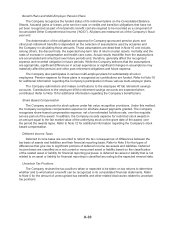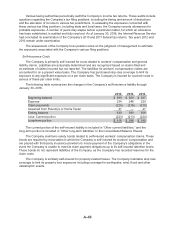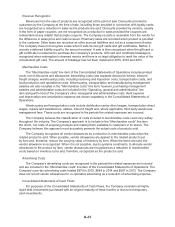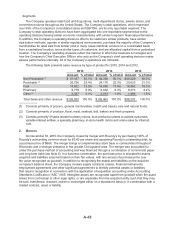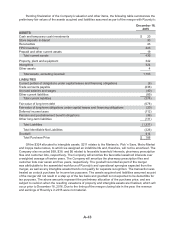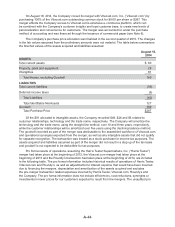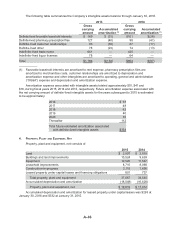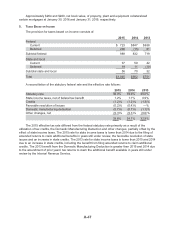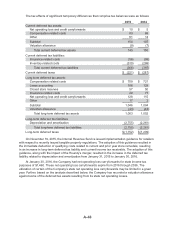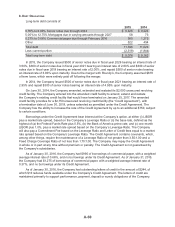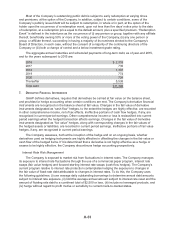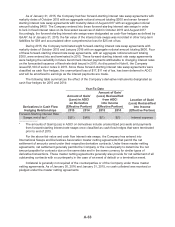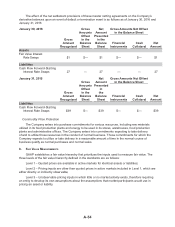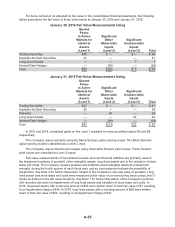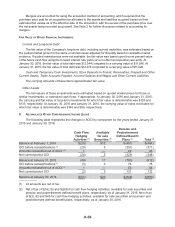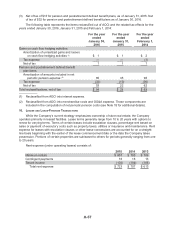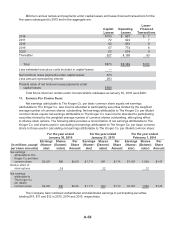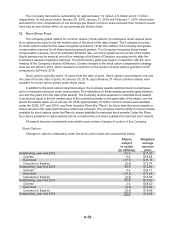Kroger 2015 Annual Report Download - page 123
Download and view the complete annual report
Please find page 123 of the 2015 Kroger annual report below. You can navigate through the pages in the report by either clicking on the pages listed below, or by using the keyword search tool below to find specific information within the annual report.
A-49
At January 30, 2016, the Company had state credit carryforwards of $65, most of which expire
from 2016 through 2027. The utilization of certain of the Company’s credits may be limited in a given
year. Further, based on the analysis described below, the Company has recorded a valuation allowance
against some of the deferred tax assets resulting from its state credits.
At January 30, 2016, the Company had federal net operating loss carryforwards of $62. These net
operating loss carryforwards expire from 2030 through 2034. The utilization of certain of the Company’s
federal net operating loss carryforwards may be limited in a given year. Further, based on the analysis
described below, the Company has not recorded a valuation allowance against the deferred tax assets
resulting from its federal net operating losses.
The Company regularly reviews all deferred tax assets on a tax filer and jurisdictional basis to
estimate whether these assets are more likely than not to be realized based on all available evidence.
This evidence includes historical taxable income, projected future taxable income, the expected timing
of the reversal of existing temporary differences and the implementation of tax planning strategies.
Projected future taxable income is based on expected results and assumptions as to the jurisdiction in
which the income will be earned. The expected timing of the reversals of existing temporary differences
is based on current tax law and the Company’s tax methods of accounting. Unless deferred tax assets
are more likely than not to be realized, a valuation allowance is established to reduce the carrying value
of the deferred tax asset until such time that realization becomes more likely than not. Increases and
decreases in these valuation allowances are included in “Income tax expense” in the Consolidated
Statements of Operations.
A reconciliation of the beginning and ending amount of unrecognized tax benefits, including
positions impacting only the timing of tax benefits, is as follows:
2015 2014 2013
Beginning balance $246 $325 $299
Additions based on tax positions related to the current year 11 17 23
Reductions based on tax positions related to the current year (11) (6) (10)
Additions for tax positions of prior years 4 9 17
Reductions for tax positions of prior years (27) (36) (4)
Settlements (17) (63) —
Lapse of statute (2) — —
Ending balance $204 $246 $325
The Company does not anticipate that changes in the amount of unrecognized tax benefits over the
next twelve months will have a significant impact on its results of operations or financial position.
As of January 30, 2016, January 31, 2015 and February 1, 2014, the amount of unrecognized tax
benefits that, if recognized, would impact the effective tax rate was $83, $90 and $98, respectively.
To the extent interest and penalties would be assessed by taxing authorities on any underpayment
of income tax, such amounts have been accrued and classified as a component of income tax expense.
During the years ended January 30, 2016, January 31, 2015 and February 1, 2014, the Company
recognized approximately $(5), $3 and $10, respectively, in interest and penalties (recoveries). The
Company had accrued approximately $25, $30 and $41 for the payment of interest and penalties as of
January 30, 2016, January 31, 2015 and February 1, 2014, respectively.
As of January 31, 2015, the Internal Revenue Service had concluded its examination of our 2010
and 2011 federal tax returns and is currently auditing tax years 2012 and 2013. The 2012 and 2013 audits
are expected to be completed in 2016.


